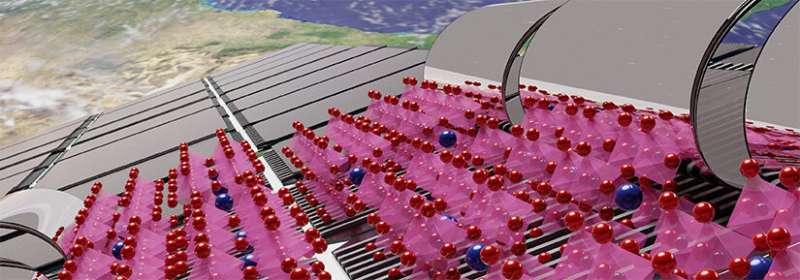Coating provides radiation barrier for perovskites in space, protection from elements on Earth

An ultrathin protective coating proves sufficient to protect a perovskite solar cell from the harmful effects of space and harden it against environmental factors on Earth, according to newly published research from the U.S. Department of Energy’s National Renewable Energy Laboratory (NREL).
The NREL research was done for the Air Force Research Laboratory (AFRL) to develop low-cost innovative energy sources for powering the armed forces worldwide, and the corresponding paper is published in Nature Energy.
The research is the latest effort to determine the effectiveness of perovskites for use in space applications, where it would be exposed to protons, alpha particles, atomic oxygen, and other stressors. The ability to use perovskites to generate power in space is enticing because they offer a lower-cost and lightweight option to other technologies with the potential for achieving efficiencies similar to those of current space PV technologies.
Just as on Earth, perovskite solar cells need to have suitable durability. However, the environment in space is significantly different. While the biggest challenges on Earth are related to weather, in space perovskites must address the problems that come from radiation bombardment and extreme temperature swings. Perovskites show signs of better tolerance to radiation than many other solar cells, but plenty of testing remains to be conducted.
Researchers last year ran simulations to demonstrate how exposure to radiation in space would affect perovskites. They determined the next-generation technology would work in space but pointed out the need to encapsulate the cell in some way to provide added protection.
In the follow-up research, Ahmad Kirmani, lead author of the latest Nature Energy paper, said simulations demonstrated a micron-thick layer of silicon oxide would preserve the efficiency and increase the lifetime of perovskite solar cells in space. As a comparison, the micron-thick layer is about 100 times thinner than a typical human hair.
Kirmani said the silicon oxide layer could reduce the weight of conventional radiation barriers used for other solar cells by more than 99% and serves as a first step toward designing lightweight and low-cost packaging for perovskites.
High-energy protons travel through perovskite solar cells without causing much harm. Low-energy protons, however, are more abundant in space and wreak more havoc on perovskite cells by knocking atoms out of place and causing efficiency levels to steadily decline. The lower energy protons interact with matter much more readily and the addition of the silicon oxide layer protected the perovskite from damage even from the low-energy protons.
“We thought it would be impossible for the silicon oxide to provide protection against fully penetrating long-range particles such as the high-energy protons and alpha particles,” Kirmani said. “However, the oxide layer turned out to be a surprisingly good barrier against those as well.”
The results are detailed in the paper “Metal oxide barrier layers for terrestrial and space perovskite photovoltaics.” The co-authors are David Ostrowski, Kaitlyn VanSant, Rosemary Bramante, Karen Heinselman, Jinhui Tong, Bart Stevens, William Nemeth, Kai Zhu, and Joseph Luther, from NREL; and several key collaborators who work with the team from the University of North Texas and the University of Oklahoma. VanSant holds the unique position of being a postdoctoral researcher at NASA who conducts research at NREL.
Exposure to a stream of low-energy protons caused unprotected perovskite solar cells to lose only about 15% of their initial efficiency, the researchers found. A larger concentration of particles destroyed the cells, while the protected perovskites demonstrated what the scientists described as “a remarkable resilience.” With the simple barrier, the cells showed no damage.
In addition to making the cells more resilient in space, the researchers also tested how the barrier could provide benefit in more conventional applications. They then exposed the perovskite solar cells to an uncontrolled moisture and temperature environment for several days to mimic storage conditions. The protected cells retained their initial 19% efficiency, while the unprotected cells showed significant degradation, from 19.4% to 10.8%. The oxide layer also provided protection when other perovskite compositions typically more sensitive to moisture were exposed to water.
Further, the perovskite solar cells were subjected to a test chamber where they were bombarded with ultraviolet photons similar to the environment at low-Earth orbit. The photons interacted with oxygen to create atomic oxygen. The unprotected cells were destroyed after eight minutes. The protected cells retained their initial efficiency after 20 minutes and only had a slight drop after 30 minutes.
The simulations and experiments revealed that by reducing the damage from radiation, the lifetime of the protected solar cells used in Earth’s orbits and deep space would be increased from months to years.
“Power conversion efficiency and operational stability of perovskite solar cells have been the two primary focus areas for the community so far,” he said. “We have made a lot of progress and I think we have come far to the point that we might be pretty close to hitting those targets needed for industrialization. However, to really enable this market entry, packaging is the next target.”
Because perovskite solar cells can be deposited onto a flexible substrate, the emerging technology, coupled with the protective layer of silicon oxide, allows its use for various terrestrial applications such as powering drones.
More information:
Ahmad R. Kirmani et al, Metal oxide barrier layers for terrestrial and space perovskite photovoltaics, Nature Energy (2023). DOI: 10.1038/s41560-022-01189-1
Citation:
Coating provides radiation barrier for perovskites in space, protection from elements on Earth (2023, January 27)
retrieved 27 January 2023
from https://techxplore.com/news/2023-01-coating-barrier-perovskites-space-elements.html
This document is subject to copyright. Apart from any fair dealing for the purpose of private study or research, no
part may be reproduced without the written permission. The content is provided for information purposes only.
For all the latest Technology News Click Here
For the latest news and updates, follow us on Google News.

